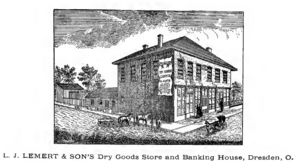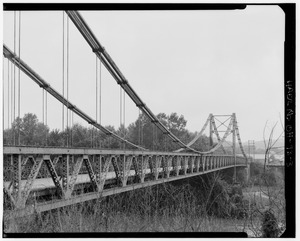Dresden, Ohio facts for kids
Quick facts for kids
Dresden, Ohio
|
|
|---|---|
|
Village
|
|
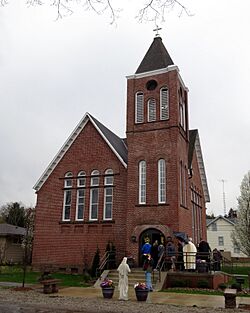
Saint Ann Catholic Church in Dresden
|
|
| Nickname(s):
Basket Village USA
|
|
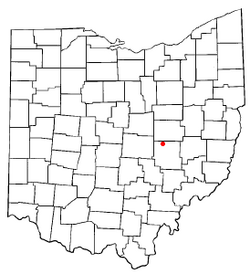
Location of Dresden, Ohio
|
|
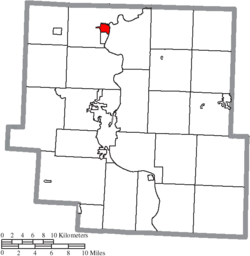
Location of Dresden in Muskingum County
|
|
| Country | United States |
| State | Ohio |
| County | Muskingum |
| Townships | Jefferson, Cass |
| Area | |
| • Total | 1.31 sq mi (3.40 km2) |
| • Land | 1.28 sq mi (3.31 km2) |
| • Water | 0.04 sq mi (0.09 km2) |
| Elevation | 735 ft (224 m) |
| Population
(2020)
|
|
| • Total | 1,650 |
| • Estimate
(2023)
|
1,647 |
| • Density | 1,291.08/sq mi (498.58/km2) |
| Time zone | UTC-5 (EST) |
| • Summer (DST) | UTC-4 (EDT) |
| ZIP code |
43821
|
| Area code(s) | 740 |
| FIPS code | 39-22610 |
| GNIS feature ID | 2398748 |
| Website | http://www.villageofdresden.com/ |
Dresden is a small village in Muskingum County, Ohio, United States. It is located along the Muskingum River where the Wakatomika Creek flows into it. In 2020, about 1,650 people lived there. Dresden is part of the Zanesville micropolitan area. It officially became a village on March 9, 1835.
Contents
History of Dresden
Early Days and Native Americans
Dresden is built on or near the site of an old Shawnee Native American village called Wakatomika. This village gave its name to the nearby Wakatomika Creek. In 1773, a missionary named David Zeisberger visited to try and convert the Shawnee people.
However, there was tension between the Native Americans and white settlers. On August 7, 1774, Colonel Angus McDonald led 400 soldiers from Fort Pittsburg. They fought the Shawnee in what was called the Wakatomica Campaign during Lord Dunmore's War. The village of Wakatomika and four other villages were burned down.
First Settlers and Growth
In 1799, Jonathan Cass became one of the first settlers in the area. He claimed a large piece of land, about 4,000 acres. His family joined him in 1801. Major Jonathan Cass was a soldier who fought in the American Revolution. He was at the Battle of Bunker Hill.
Another early settler was Seth Adams from Boston, who also arrived in 1799. He was known for growing the first tomatoes in the county. He also planted apple trees and helped bring a special kind of sheep, called Merino sheep, to the United States.
In the early 1800s, more people moved to the area. In 1804, Seth Adams built a mill to grind corn. The first local election for Jefferson Township was held in 1805.
Dresden as a Trading Hub
In the 19th century, Dresden became an important trading town. This was thanks to the Ohio and Erie Canal. A special side canal connected the Ohio and Erie Canal to the Muskingum River. This made it easy to transport goods.
More businesses opened in Dresden. In 1817, Laban Lemert opened the first store. Soon after, John Cordray started a tavern. Other businesses like tanneries and weaving shops also appeared. In 1821, the first castor oil mill west of the Allegheny Mountains was built in Dresden.
The main part of the Ohio Canal was finished in 1829. The Dresden side-cut canal was ready in 1831. This helped the town grow even more.
Churches and Community Life
The first Presbyterian church services in Dresden were held in 1825. A building committee was formed in 1836 to build a proper church, which was finished in 1838. The Methodist Episcopal church also built a brick building in 1835. Other churches, like the Zion Protestant Episcopal Church and the Baptist church, were formed later.
On March 8, 1835, Dresden officially became an incorporated village. This meant it could have its own local government.
Newspapers and Communication
The town's first newspaper, Dresden Chronicle, was published on July 30, 1838. It changed names several times over the years. By 1879, it became The Dresden Transcript, which was still being published weekly in 2013.
In 1848, a telegraph line connected Dresden to Zanesville and Wooster. This brought faster communication to the village.
Building the Suspension Bridge
In 1852, George Willison Adams helped build a suspension bridge across the Muskingum River near Dresden. It was one of the first three suspension bridges in the United States. The bridge was 1,000 feet long and cost $30,000. It was a toll bridge for a while. Sadly, this bridge was destroyed in the Great Flood of 1913.
The first bank in Dresden opened in 1852, followed by a second one in 1866.
20th Century and Beyond
In 1901, the Dresden telephone exchange was built, connecting the first phone users by November of that year.
Dresden is famous as the birthplace of the Longaberger Company. This company made handmade maple splint baskets. It started in 1919 and became the largest maker of handmade baskets in the United States, employing almost 2,000 people. The company closed in 2018. Dresden is also home to "The World's Largest Basket," according to the Guinness Book of World Records.
A natural gas power plant, called the Dresden Plant, was built south of Dresden. It started making electricity in 2012.
Geography
Dresden is a small village with a total area of about 1.18 square miles (3.06 square kilometers). Most of this area is land, with a small part being water.
Climate
| Climate data for Dresden, Ohio | |||||||||||||
|---|---|---|---|---|---|---|---|---|---|---|---|---|---|
| Month | Jan | Feb | Mar | Apr | May | Jun | Jul | Aug | Sep | Oct | Nov | Dec | Year |
| Record high °F (°C) | 75 (24) |
75 (24) |
86 (30) |
90 (32) |
95 (35) |
103 (39) |
105 (41) |
102 (39) |
106 (41) |
92 (33) |
83 (28) |
77 (25) |
106 (41) |
| Mean daily maximum °F (°C) | 36 (2) |
41 (5) |
51 (11) |
63 (17) |
72 (22) |
80 (27) |
84 (29) |
82 (28) |
76 (24) |
65 (18) |
52 (11) |
40 (4) |
62 (17) |
| Mean daily minimum °F (°C) | 20 (−7) |
23 (−5) |
30 (−1) |
40 (4) |
49 (9) |
58 (14) |
62 (17) |
61 (16) |
53 (12) |
41 (5) |
33 (1) |
24 (−4) |
41 (5) |
| Record low °F (°C) | −24 (−31) |
−20 (−29) |
−6 (−21) |
11 (−12) |
20 (−7) |
31 (−1) |
41 (5) |
39 (4) |
27 (−3) |
17 (−8) |
−5 (−21) |
−19 (−28) |
−24 (−31) |
| Average precipitation inches (mm) | 2.98 (76) |
2.53 (64) |
3.34 (85) |
3.80 (97) |
4.55 (116) |
4.04 (103) |
4.41 (112) |
3.65 (93) |
3.13 (80) |
2.89 (73) |
3.48 (88) |
3.04 (77) |
41.84 (1,064) |
Population Data
| Historical population | |||
|---|---|---|---|
| Census | Pop. | %± | |
| 1830 | 391 | — | |
| 1840 | 819 | 109.5% | |
| 1850 | 1,445 | 76.4% | |
| 1860 | 1,409 | −2.5% | |
| 1870 | 1,156 | −18.0% | |
| 1880 | 1,204 | 4.2% | |
| 1890 | 1,247 | 3.6% | |
| 1900 | 1,600 | 28.3% | |
| 1910 | 1,549 | −3.2% | |
| 1920 | 1,700 | 9.7% | |
| 1930 | 1,362 | −19.9% | |
| 1940 | 1,350 | −0.9% | |
| 1950 | 1,310 | −3.0% | |
| 1960 | 1,338 | 2.1% | |
| 1970 | 1,516 | 13.3% | |
| 1980 | 1,646 | 8.6% | |
| 1990 | 1,581 | −3.9% | |
| 2000 | 1,423 | −10.0% | |
| 2010 | 1,529 | 7.4% | |
| 2020 | 1,650 | 7.9% | |
| 2023 (est.) | 1,647 | 7.7% | |
| U.S. Decennial Census | |||
How Many People Live Here?
According to the 2010 census, there were 1,529 people living in Dresden. There were 651 households, which are groups of people living together.
About 28% of the population was under 19 years old. The average age in the village was 39 years.
Historic Structures
Dresden has several interesting old buildings and structures:
- The Union School, built in 1882.
- The Triple Locks of the Ohio and Erie Canal side cut canal. These were special gates that helped boats move between different water levels.
- The Episcopal Church, built in 1852.
- The historic 1914 metal link suspension bridge across the Muskingum River.
Education
Dresden is part of the Tri-Valley Local School District. The village is home to Dresden Elementary School, Tri-Valley Middle School, and Tri-Valley High School.
The Muskingum County Library System also has a branch in Dresden.
Notable People
- George Willison Adams, an important businessman who was also president of the Northern Pacific Railway.
Images for kids
See also
 In Spanish: Dresden (Ohio) para niños
In Spanish: Dresden (Ohio) para niños


